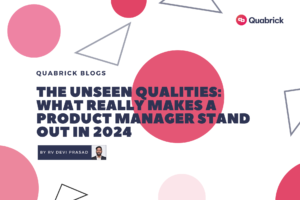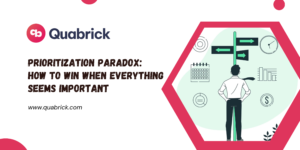Product Managers (PMs) stand at the helm of innovation, often juggling multiple responsibilities that span from strategic planning to market research, all while keeping a keen eye on customer feedback and team dynamics. It’s a role that demands not only technical expertise but also creative problem-solving and impeccable communication skills. This is where ChatGPT enters the picture as a transformative tool for PMs seeking to elevate their game.
Quabrick recognizes the transformative potential of AI in shaping the future of product management. Through this blog, we will explore 13 groundbreaking ways ChatGPT can assist PMs, enhancing their efficiency and effectiveness. From distilling complex information into digestible “Quick Bytes” to providing a “Second pair of eyes” for content review, ChatGPT serves as a versatile ally in the product development process. Whether it’s crafting the perfect copy with “Copy Craft” or keeping a finger on the pulse of market trends, ChatGPT’s capabilities are poised to revolutionize the field of product management.
ChatGPT’s Role in Streamlining Product Management Tasks
Navigating the complexities of product management can often feel like a high-wire act, especially when you’re tasked with articulating your vision through crucial communication like emails or sifting through mounds of customer feedback for actionable insights. In those moments, seeking inspiration to clear the blockages can be as crucial as the next step on your product roadmap. Fortunately, the digital age has brought with it a sophisticated AI companion, ready to assist you right where you are.
Picture this: It’s Thursday evening, the week has stretched your cognitive bandwidth, and your eyes are weary. You’re on the cusp of initiating the next major release of your product, and you need to craft a Product Requirements Document (PRD) that captures the essence of new features, the target customer segments, and the core issues your update aims to address. This is where the rubber meets the road, but you find yourself at a standstill, unsure how to orchestrate the wealth of information into a structured and coherent document. This is the perfect moment for the “Product Pro” use case to take the stage—simply feed it the relevant details, and like a seasoned conductor, it will orchestrate your PRD effortlessly.
But why stop there? To empower your product management journey even further, here’s a curated list of use cases where ChatGPT can seamlessly integrate into your workflow, each designed to enhance your efficiency and unlock your creative potential. Let’s take a look.

Examples to get you started
Quick Bytes – Get a summary of a large piece of text when you don’t have the time to read it in full.

WordSmith – Get help writing content or finetuning emails to ensure they’re polished and effective.

BrainTrust – Collaborate with a sparring partner to receive feedback and critiques on your ideas and documents.

Jargon Buster – Get help understanding technical concepts and debugging APIs to become more tech-driven.

Practice it yourself with a template

The above image is a template for the underlying philosophy one can take to any question on the list.
At Quabrick, we understand the multifaceted challenges that Product Managers face daily. To help you harness the full potential of AI in your role, we’ve crafted a DIY guide that enables you to practice and refine your skills using ChatGPT. Each use case in the table above is accompanied by a generic prompt or question, designed to simulate real-world scenarios you might encounter.
For each use case, we encourage you to write out your responses or solutions as if you were addressing the issue directly. To aid in this exercise, consider creating templates for each scenario. Here’s how you can approach it:
- Quick Bytes: Template a brief for summarizing articles, highlighting the key points related to specific topics you often deal with.
- Second pair of eyes: Develop a checklist or a feedback form that helps you methodically review product specs.
- WordSmith: Create an email template for new product announcements, leaving placeholders for the product’s unique features.
- QuestionWizard: Draft a survey template with diverse question types aimed at understanding customer opinions on new features.
- BrainTrust: List the options you’re considering for market expansion and create a template for additional suggestions and gap analysis.
- PulseCheck: Formulate a feedback analysis sheet that helps you categorize customer sentiments and areas needing improvement.
- MinutesMaster: Set up a meeting minutes template that includes sections for action items and key takeaways.
- HelpDesk Hero: Assemble a FAQ draft based on common feedback themes from customer reviews.
- Jargon Buster: Design a glossary template for explaining technical terms and their applications.
- Journey Genius: Sketch a customer journey map template that identifies pain points and improvement opportunities.
- Product Pro: Create a detailed PRD template that covers product features and addresses specific pain points.
- Market Tracker: Outline a market trends report template that includes data sources and competitive analysis.
- Copy Craft: Develop a marketing message framework that helps tailor the tone and messaging to your target audience.
By practicing with these templates, you’ll be better prepared to tackle the challenges of product management with confidence and creativity.
Conclusion
In the landscape of product management, the agility to innovate and the proficiency to adapt are as critical to your success as the quality of the product you’re managing. The use cases and exercises presented in this DIY guide are designed not just to streamline your workflow with ChatGPT’s assistance but to also deepen your understanding of AI’s potential in product management.
As you put these templates into practice, remember that they are not static. They should grow and evolve with your experience, the same way your products do. Regular refinement based on new insights and feedback is what will drive your efficiency and effectiveness to new heights.
For more in-depth insights on how Product Managers can seamlessly integrate AI into their work, be sure to explore our comprehensive guide on Quabrick’s website. It’s an invaluable resource that complements the practical tips shared here and provides you with a broader understanding of AI’s strategic application in product management.





